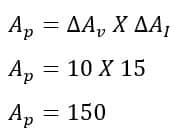Voltage, Current, and Power Gain of an Amplifier is the ratio of respective output quantity to input quantity. Here, quantity means voltage, current, and power. The sensor or transducer in the instrumentation system converts physical quantities into electrical quantities. The output of the transducer is in order of a few millivolts. The signal needs amplification for further processing. Thus, an amplifier boosts the strength of the weak signal. In this article, we will learn the types of amplifier gain and their significance.
Types of Amplifier Gain
Voltage Gain
The amplifiers have the ability to increase the strength of the input signal. The technical term that shows the amplifying capacity of an amplifier is the gain. The gain of the amplifier indicates how many times the output signal is with respect to the input signal. Thus, the ratio of the output signal to the input signal is called the gain of the amplifier. The gain is the dimensionless quantity. The capital letter “A” is used to show the amplifier gain.
The ratio of the output voltage to the input voltage is called voltage gain.
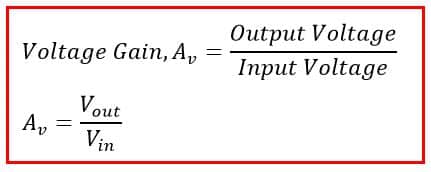
The voltage gain can also be represented by the ratio of the change in the output voltage to the change in input voltage. Mathematically, we can express the voltage gain as;

Voltage Gain Calculation
An amplifier takes in 1 volt (RMS) as its input and outputs 10 volts(RMS). Then, its AC voltage gain is 10 divided by 1, or 10.
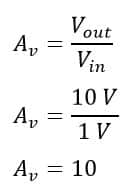
An amplifier output changes from 1 volt to 5 volts when its input changes from 0.1 volts to 0.5 volts, then the voltage gain is;
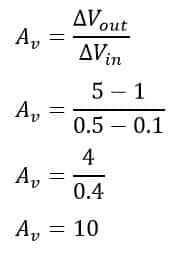
Current Gain
The ratio of the output current and input current of the amplifier is called the current gain. The current gain indicates the amplifier’s capacity to deliver the maximum output current to the load with respect to a particular applied input current.
The mathematical formula of current gain is;
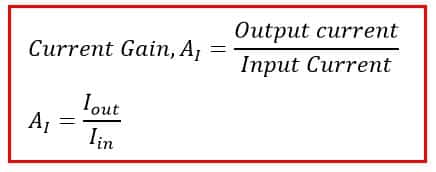
The current gain can also be represented by the ratio of change in the output current to the change in the input current. Mathematically, we can express the current gain as;

Current Gain Calculation
An amplifier takes in 1 mA(RMS) as its input and outputs 100 mA volts. Then, its AC voltage gain is 100 divided by 1, or 100.
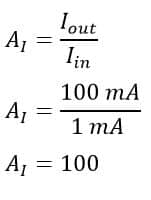
An amplifier output current changes from 10 mA to 100 mA when its input current changes from 0.1 mA to 1 mA, then the current gain is;
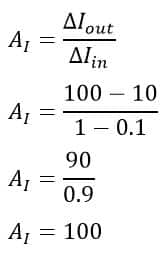
Power Gain
The ratio of output power to the input power of an amplifier circuit is called power gain. It shows the capacity of a circuit to amplify power with respect to the input power. This term is very important for RF amplifiers. The RF amplifier boosts the power of RF signals for wireless transmission.
The ratio of output power to input power is called power gain.
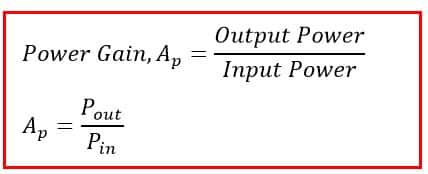
The power gain can also be represented by the ratio of change in the output power to the change in input power. Mathematically, we can express the power gain as;

We can express the power gain of the amplifier as;
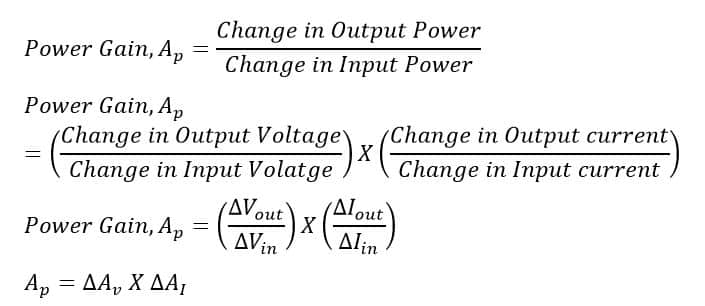
Thus, the power gain is the product of the voltage gain and the current gain.
Power Gain Calculation
An amplifier takes in 10 mW(RMS) as its input and outputs 100 mW. Then, its AC power gain is 100 divided by 10, or 10.
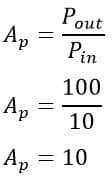
An amplifier’s output power changes from 10 mW to 100 mW when its input power changes from 0.1 mW mA to 1 mW, then the power gain of the amplifier is;

The current gain and voltage gain of an amplifier is 15 and 10 respectively then the power gain of the amplifier is;
